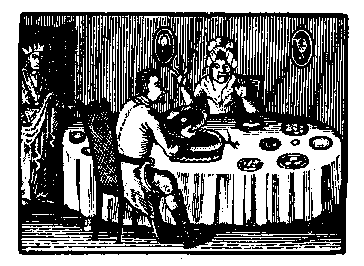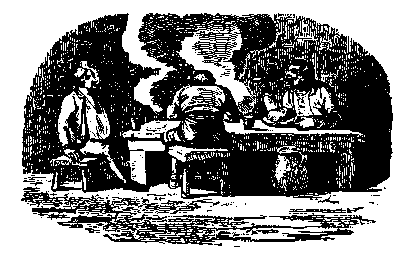from
Uppland
#3
Dr. Phage
 I have before me the week's menu of specials at the Sven Duva Restaurant, near my location at the BMC. For an experienced world-traveller like myself, with a smattering of several foreign languages and a sharp eye for English cognates, these exotic Swedish dishes hold no terrors. For example, Tonsfisksallad med Sardeller och Oliver is obviously tunafish salad with sardines and olives, unless reference is being made to someone named Oliver. Spansk Bondomelett is obviously Spanish omelette with Bondo. And Pelotas en Salsa Roja is without a doubt baseballs in red sauce, although I am at a loss to explain what it is doing on a Swedish menu.
I have before me the week's menu of specials at the Sven Duva Restaurant, near my location at the BMC. For an experienced world-traveller like myself, with a smattering of several foreign languages and a sharp eye for English cognates, these exotic Swedish dishes hold no terrors. For example, Tonsfisksallad med Sardeller och Oliver is obviously tunafish salad with sardines and olives, unless reference is being made to someone named Oliver. Spansk Bondomelett is obviously Spanish omelette with Bondo. And Pelotas en Salsa Roja is without a doubt baseballs in red sauce, although I am at a loss to explain what it is doing on a Swedish menu. A few cases present graver difficulties. What, for example, does one make of Farsfylld Rådjursbog med Sky och Höstpytt? Rendering it as Farfelled Roger's Bog with Sky and Hot Spit may be just a teeny bit off the mark. Then we have Ugnsstekt Afrikansk Mal, Tomat-och Spiskummin, which could mean Unstuck African Badness (as in mal de mer), Tomatoes and Spies Coming In, but that doesn't really help either. Ultimately, one must have recourse to the dictionary. In the present case, unfortunately, one discovers that mal in Swedish means moth, which does not make the Afrikansk dish sound a lot more tempting, to tell the truth. Then there is Helstekt Kalkonbröst med Råtgräddåss. The hell with it.
Trying to decode Swedish from English cognates works in many cases (my favorite being hackad biff, which is hamburger) but there are hidden pitfalls. For example, gris means not grease but pig, while pigg means not pig but the adjective brisk, and piggvar is a type of fish.
Cognate words sometimes reflect a twisted historical path. Svamp means mushroom in Swedish, reflecting, perhaps, the kind of ground you can find mushrooms in. The Swedish word for the Autumn season is höst, and that has its English cognate too, but it is not immediately obvious. In Scots dialect, the word for the same season is hairst, which makes the relationship a little clearer: harvest, what the farmer does at that time of year. Which brings us back to that dish above with höstpytt. Whatever it is, it includes some seasonal Autumn creature.
Probably potatoes, even if potatis is not named explicitly. Every second Swedish dish involves potatoes. And onions. And herring. There are dozens of dishes based on this mighty trio, differing only in the order in which they are assembled, and the time of day that one does it. These various dishes are all exactly alike, although my personal favorite is Janssons frestelse, because of its delicious name.
One cannot discuss Swedish cuisine without some mention of herring, which is the national bird. There is a particularly refined type in the Baltic called strömming, which swim in gymnasia rather than ordinary schools, and speak French among themselves. A special delicacy is created from these strömming by burying them in the backyard and allowing them to ferment. After a year or two, they are dug up to produce a fish sauce which was used as a secret weapon during the days when Sweden's army was the terror of Northern Europe.
The more common form of the noble herring is called sill in Swedish. It comes in six species called loek sill, inlagd sill, maatjes sill, sill med senapsås, and so on. Each one is better than the last. When I leave this country, I am going to make a profound, existentialist movie about a hitherto unknown species of herring and the meaning of life. It will be called "The Seventh Sill."
The historical Sweden or Sverige takes its name from from the Svear, a tribe of foresters, miners, trolls, and Social Democrats whose origins are shrouded in mystery, except that most of them have cousins in Minnesota. They occupied the eastern middle part of the country, where Stockholm and the towns around Lake Maelaren lie today, and their kingdom spread north and northwest but only a little to the southwest. Most of modern southern Sweden, including its most fertile farming province, Skåne, remained an integral part of Denmark until well into the 17th century.
Lund, in Skåne, was the seat of the Archbishop of Denmark, and there is a magnificent 12th century Romanesque cathedral there to this day, as well as a jumble of indescribably picturesque medieval buildings. But in 1658, the treaty of Roskilde turned Skåne and the rest of the South over to the Swedish monarchy. In return, the Danes, were able to turn to the arts of peace, (after 200 years of intermittent war with Sweden), and in no time at all they invented the Leggo. The rest is history. Sweden gained the cows of Skåne, and the cows' owners, but lost the Leggo.
In fact, the Skånians were none too enthusiastic about joining Sweden. It wasn't nearly as picturesque as Denmark, or as Lund already was, it was inhabited by a gang of fur-hatted trolls with relatives in Minnesota, and the price of booze was so much higher than in Denmark. But the Swedish king, Gustav the Waterlogged, was determined to win the Skånians over. They want picturesque, I'll give them picturesque, he is reported to have said to a courtier. So he established a University in Lund, and built for it magnificent 17th century buildings, scattered amongst the jumble of medieval buildings already there. (Northern Europeans have long viewed the building of Universities as public improvement, much as Americans think of freeways or football stadiums.)
The result is a town which is almost unbearably quaint, a kind of architectural-historical Disneyland. Walking about in Lund, I almost longed to come across a tacky motel, a garish billboard, or a used-car lot. But nothing of the kind can be found. Even MacDonalds' and 7-11 (which have branches everywhere in Sweden) occupy buildings with cornices and pediments in Lund.
However, the more things change, the more they remain the same. I stepped into one magnificent 17th century University building, and noticed a magnificent wood-panelled dining room that was equipped as a bar. It was not in use yet, the hour being before 10 AM. In the corridor outside the bar, there was an UNmagnificent, coin-operated, self-service breathalyzer, something I had never seen before. It must be an important convenience, in a country where the maximum blood alcohol level permitted for legal operation of a car is 0.02%. I know people who spent years, decades, in a state that would not have permitted them to drive legally in Sweden ever, night or day. So booze may have become more costly in Lund after the Treaty of Roskilde, but it certainly didn't go out of use.
North and a little West of Lund lies Västkusten, Sweden's answer to Pismo Beach. This is the strip of western coastline opposite Denmark, along an arm of the North Sea. There are real, sandy beaches to be found along this coastline, and thousands of Swedes come here in the Summer. They frolic in the pallid Northern sun, swelter in temperatures that sometimes break 70, and some even go swimming in the frigid water of the North Sea. Perhaps, come to think of it, the breathalyzer in Lund can be used to determine a minimum for swimming as well as a maximum for driving.
 It was on one of these sandy beaches on Sweden's West Coast that Ingmar Bergman shot his magnificent fable. I think I passed the very place on the train, somewhere between Helsingborg and Halmstad. As the train raced along, I saw the sandy beach and when I blinked, I seemed to see The Knight and Death sitting there on the beach, still deep in their game of chess. When a film-maker creates images of a certain power, they stay on the beach, or in the mind, and they never leave.
It was on one of these sandy beaches on Sweden's West Coast that Ingmar Bergman shot his magnificent fable. I think I passed the very place on the train, somewhere between Helsingborg and Halmstad. As the train raced along, I saw the sandy beach and when I blinked, I seemed to see The Knight and Death sitting there on the beach, still deep in their game of chess. When a film-maker creates images of a certain power, they stay on the beach, or in the mind, and they never leave.